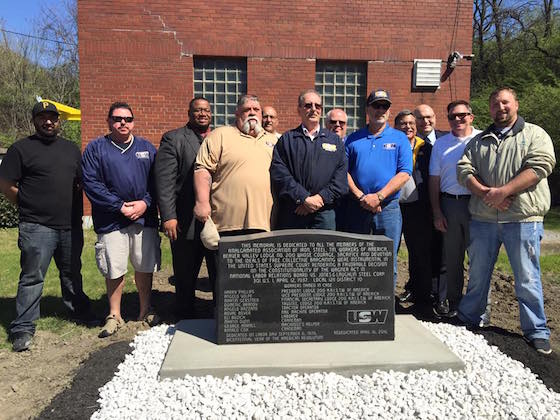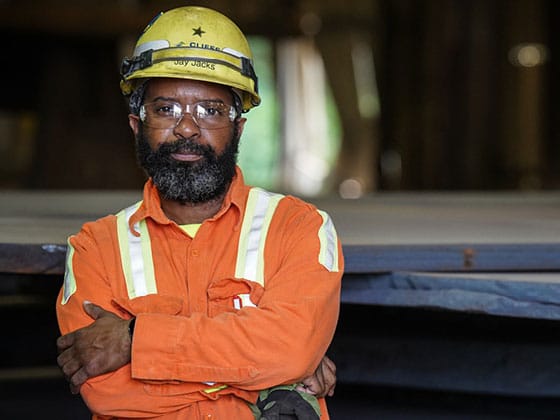Local 1211 helps mark history at site considered birthplace of our union
For United Steelworkers members from Local 1211, rededicating a historical marker at the birthplace of our union was about making sure the struggle, sacrifices and contributions of our founding sisters and brothers will never be forgotten.

“This is part of our union’s history and our nation’s history that we need to protect and share,” said Christ Atsidis, vice president of USW Local 1211 in Baden, Pa. Atsidis spearheaded efforts to replace the marker after it was vandalized, including research, fundraising and planning a ceremony in Aliquippa in April.
The memorial commemorates the 1937 landmark U.S. Supreme Court ruling that gave American working people the right to form unions and negotiate together for better lives.
Among those in attendance at the ceremony were USW District 10 Director Bobby “Mac” McAuliffe, several members of SOAR, Beaver County Commissioner Tony Amadio; Congressional candidate Erin McClelland; Rep. Robert Matzie, D-Pa.; Aliquippa Mayor Dwan Walker; Pennsylvania AFL-CIO President Frank Snyder; Beaver-Lawrence CLC President Rick Galiano of USW Local 9305; USW Local 1211 President Bart Carr; several 1211 members and others.
“We need to remember the blood, sweat and tears of the people who fought to bring about the workers’ rights that people have today whether you’re a union member or not, “ Matzie said. “Every right that has been won by a union member benefits every working person in America. It’s not a Republican or a Democrat thing – it’s the right thing to do.”
On April 12, 1937, the nation’s highest court ruled that the National Labor Relations Board and the Wagner Act that established it was constitutional. The court ordered Jones & Laughlin Steel Corp. (J&L) to rehire workers who had been fired for union activity. The ruling meant that workers’ nationwide had a right to organize and collectively bargain.
The ruling was a big deal because it allowed millions of workers to join unions, including the eventual United Steelworkers, and stick together to speak up about working conditions, pay, benefits, hiring practices, pensions, health care and other issues that had been solely controlled by the companies.
Outside of a tunnel at the entrance of the old J&L mill in Aliquippa, an old historical marker was vandalized earlier this year. It had sat there since its original dedication on Labor Day, Sept. 6, 1976. The USW led the efforts to replace the marker with a new and improved one and got help with donations from the Labor Council and others. The large black granite memorial is engraved with the names of the 10 steelworkers from J&L’s Aliquippa, Pa., mills who were fired for trying to organize a union and fought back.
The marker is also engraved with the USW logo and reads: “This memorial is dedicated to all the members of the Amalgamated Association of Iron, Steel, Tin, Workers of America Beaver Valley Lodge No. 200 whose courage, sacrifice and devotion to the ideals of free collective bargaining were instrumental in the United States Supreme Court rendering a favorable decision on the constitutionality of the Wagner Act in National Labor Relations Board vs. Jones & Laughlin Steel Corp. 301 U.S. 1, April 12, 1937. Local 1211, District 10. “
The Wagner Act was established by Congress in 1935 and guaranteed workers the right to strike, boycott, and picket, and it required employers bargain in good faith with union representatives. The act also created the NLRB to make sure that employers complied with the new law.
At that time, U.S. Steel Corp., with some hesitation, eventually recognized the Steel Workers Organizing Committee, or SWOC, which led to our current day USW. At that time, J&L dismissed a NLRB ruling against its antiunion practices and appealed the case all the way to the U.S. Supreme Court.
After the Supreme Court ruling, SWOC called a strike for recognition at the J&L plant. On May 20, 1937, Aliquippa steelworkers voted overwhelmingly for SWOC as “exclusive bargaining agent.” It marked the first NLRB election in the steel industry. J&L was forced to rehire employees it had fired, with back pay, and to recognize SWOC. Membership cards flooded in, creating the membership base of the United Steelworkers of America, and unionization swept across America.
By clicking Sign Up you're confirming that you agree with our Terms and Conditions.
Recent News Articles
Want to Learn More?
See how the USW is making a real difference in our communities and our workplaces.
